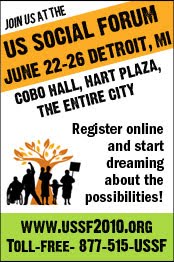Like many people involved in work with nonprofits, community groups, and other grassroots organizing efforts, I do not look forward to fundraising efforts. Asking people for money – even when I believe passionately in the cause – is often times a painful exercise that leaves me feeling like part of the “problem” I am seeking to solve.
The Fund for Democratic Communities asked me to attend the annual Money for Our Movements conference organized by the Grassroots Institute for Fundraising Training (GIFT) in Oakland, California. Over 500 organizers from around the country gathered at Mills College to discuss funding strategies, trade experience, and learn new skills through a number of excellent workshops.
In one of the sessions I attended, a presenter made the statement that fundraising should be seen as an opportunity not simply to collect money, but as a part of community building. One of the GIFT staff members offered that it is not up to us as organizers to decide who can and cannot contribute to our causes. Our job is to build sustainable movements by creating a community that interacts with and supports our efforts.
This philosophy of fundraising as community building stands in sharp contrast to the traditional process of fund development, a process that I am increasingly involved in through a number of organizations with which I work. The traditional process of developing a donor list of mailing and email addresses, sending out appeals to segments of that list defined by economic status, and planing a couple of annual events has the ability to raise large amounts of money. It is not, however, a sustainable model. The targeted donors generally do not become involved with the organization beyond activity on the board or the standard “Friends of…” committee. In the case of a human services organization, it is highly unlikely that donors (especially major donors) will ever come into contact with the people the organization serves. In this way, the traditional fundraising process buttresses the current social structure that promotes social and economic stratification and segregation.
A grassroots fundraising effort can do exactly the opposite. It can include both small donors and large donors in a way that is not demeaning or exclusionary to either. By creating a community invested in a project in ways other than financial, it becomes natural for people to contribute money to the effort because, while they may not be accessing the services or projects directly, they feel some measure of substantive involvement.
This differentiation was discussed in a session focusing on the difficult funding environment nonprofits and grassroots organizations are facing now. DataCenter and the National Organizers Alliance presented the findings of their joint study of how organizations are funding themselves during this economic downturn. While funding is becoming more and more difficult to find, organizations are developing creative ways to survive and in some cases may offer models for growth.
What is clear is that the traditional process for fundraising is becoming less reliable than in the past. Organizers must begin to reorient (if they haven’t already done so) themselves to a grassroots, bottom-up funding structure to survive and thrive in the emerging economic condition. Further, these kinds of funding strategies could serve as a method for promoting wide-spread social and economic re-conceptualizing, something in which the Fund for Democratic Communities is also currently engaged.

